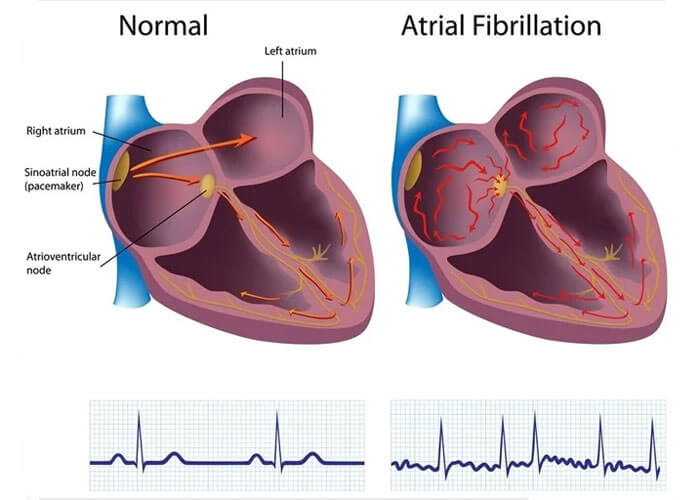
Understanding Atrial Fibrillation

Atrial fibrillation (A-fib) is a kind of arrhythmia that causes an abnormal heartbeat. It can disrupt blood flow, resulting in palpitations, chest discomfort, and shortness of breath. A-fib raises the likelihood of blood clots and stroke.
It does not usually cause symptoms, but when it does, they may include palpitations, chest tightness or discomfort, and lightheadedness.
This blog discusses how A-fib affects the heart and what symptoms and consequences may occur. It also goes over the various therapy alternatives.
Symptoms
Not everyone with A-fib will experience symptoms, and those who do may only have them occasionally. According to the Indian Medical Association (IMA), the most prevalent symptom is a fluttering heart. Other symptoms that might occur include:
palpitations, or the sensation of an irregular pulse
dyspnea, especially during exercise or exertion
chest pain, pressure, or discomfort
overall exhaustion
uncertainty or uneasiness
Causes
A-fib is caused by changes in the electrical impulses in the heart. It can occur at any age, although it is more frequent among the elderly. Other risk factors include the following:
Long-term high blood pressure can put a load on the heart.
A blood clot in the artery that distributes blood to the lung is known as a pulmonary embolism.
People with underlying cardiac issues are more likely to develop A-fib. Heart valve disease, heart failure, coronary artery disease, and heart attack are examples of these disorders.
Alcohol consumption: Although consuming significant amounts of alcohol on a daily basis puts people at the greatest risk, even small amounts might be a trigger for certain people. A-fib can also be caused by other hazardous substances, such as methamphetamine.
A-fib in the family: People who have a family history of A-fib are more likely to develop the disorder themselves.
Sleep apnea: This can raise a person's risk of A-fib, especially if severe.
Other long-term medical disorders, such as thyroid problems, asthma, diabetes, and obesity, may increase the risk.
Treatment
A-fib therapies are tailored by doctors to the individual's age and lifestyle, heart health, and general health. Some patients may merely require drugs to stabilise their cardiac rhythm, while others may require surgical operations. Doctors may propose a mix of therapies at times.
Medications
Prescription medications can regulate a person's heart rate, reduce clot formation, and, in certain cases, normalise heart rhythm.
Controlling the heart rate
If a person's heart rate is too high, lowering it can help avoid heart failure and perhaps alleviate A-fib symptoms.
Several drugs that delay the impulses that tell the heart to beat can assist. These are some examples:
Calcium channel blockers, such as diltiazem (Cardizem) and verapamil (Verelan), digoxin (Lanoxin), metoprolol (Lopressor), and atenolol (Tenormin)
Clot prevention
Dr. Sudheer may prescribe anticoagulants, often known as blood thinners. These drugs make it more difficult for blood to clot.
Using blood thinners can raise a person's risk of bleeding. However, most individuals believe that the advantages of avoiding blood clots exceed the hazards of bleeding, especially if they are at risk of stroke.
Doctors use the CHA2DS2-VASc score to assess stroke risk and determine if a patient is likely to benefit from blood thinners.
Direct-acting oral anticoagulants, such as apixaban (Eliquis), rivaroxaban (Xarelto), edoxaban (Lixiana), and dabigatran (Pradaxa), and, less often, warfarin, are examples of blood-thinning drugs.
Anyone using warfarin or similar anti-clotting medicine should inform any medical personnel who are treating them. This is especially critical during other disorders' therapy and before surgery.
Restoring a normal cardiac beat
Medication may be used by doctors to try to restore a normal cardiac rhythm. This is referred to as chemical or pharmacological cardioversion.
These anti-arrhythmic drugs can assist in converting A-fib to a regular heart rhythm or maintaining a regular rhythm.
Sodium channel blockers, such as flecainide (Tambocor), and potassium channel blockers, such as amiodarone (Pacerone), are examples.
Most patients, however, require blood-thinning drugs even after their heart rhythm returns to normal.
A-fib is a cardiac rhythm disorder that produces an irregular heartbeat. It is more common beyond the age of 65, although it does not necessarily create symptoms. If blood collects in the heart and develops a clot that goes to the brain, the condition can result in a stroke.
A-fib can be prevented by making lifestyle changes. These include eating a heart-healthy diet, reducing alcohol use, quitting smoking, keeping a healthy weight, and exercising regularly.
The treatment will focus on restoring normal cardiac rhythm and avoiding problems. Dr. Sudheer may prescribe heart-rhythm medications as well as blood-thinning medications to avoid clots. In some cases, experts may propose surgical treatments.






